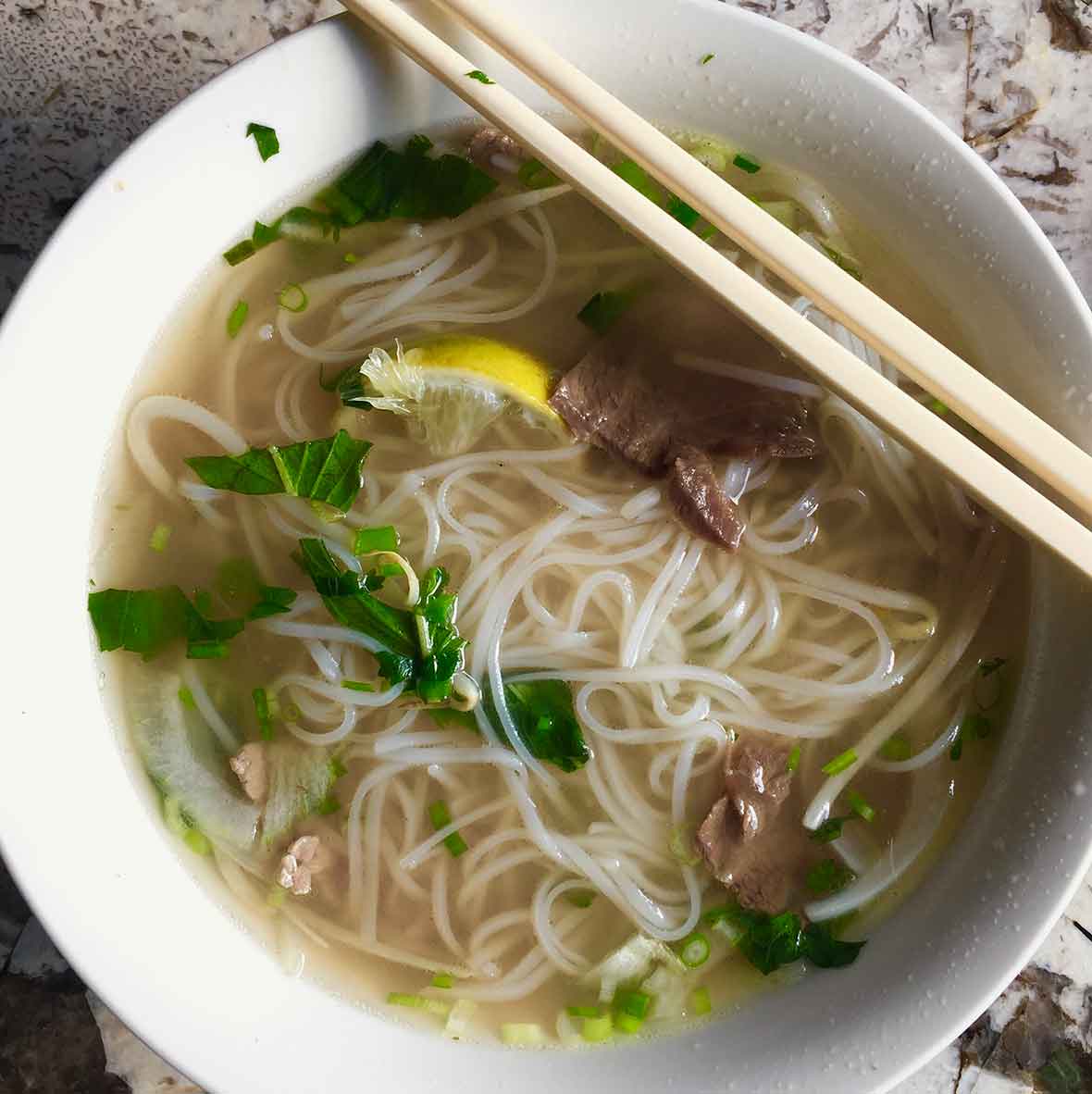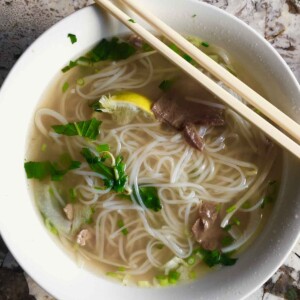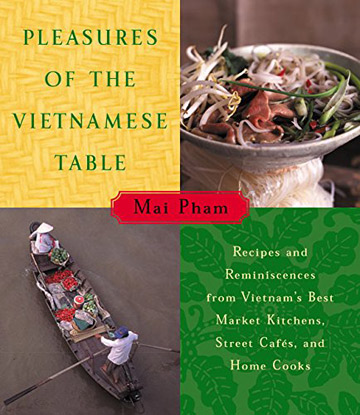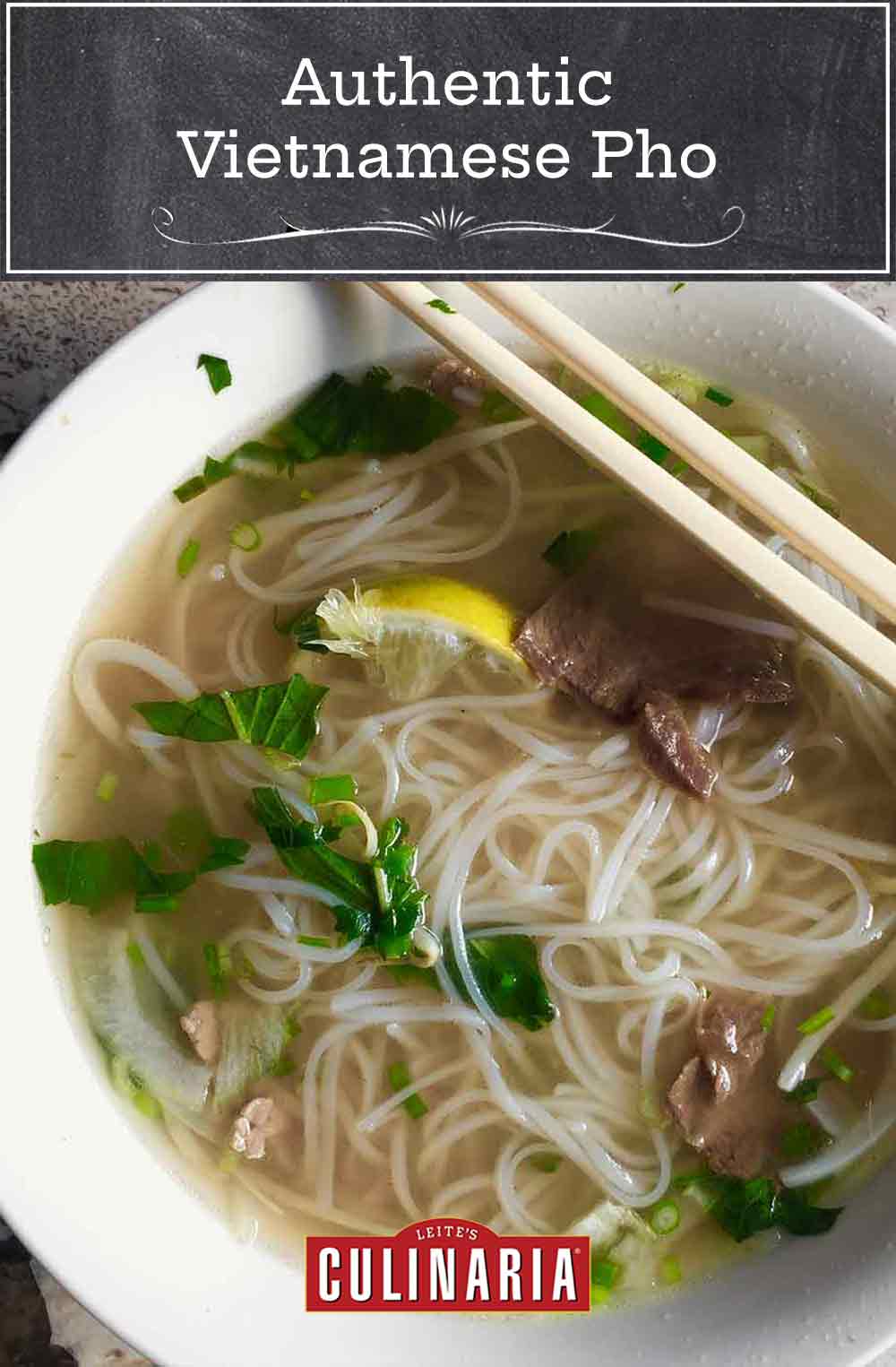
Pho (pronounced “fuh”) is an exquisitely spiced soup constructed of a clear beef broth fragrant with ginger and star anise and slippery rice noodles. It’s a beloved breakfast in Vietnam, and honestly, we can’t think of a better reason to get out of bed… any time of day.–David Leite
How to Eat Pho
Lucky you! Cookbook author Mai Pham compiled a cheat sheet on how to properly slurp pho. Here’s what she suggests… Many cookbooks call for the broth to be made with oxtail bones, but I prefer a combination of marrow bones and beef chuck, which is what pho cooks in Vietnam use. You can serve this soup with any of several different types of beef, whether rare to well-done chuck, brisket, meatballs, tripe, tendon, and so on. (The easiest ones to prepare at home are cooked and raw beef, as in the recipe that follows.) Begin by adding bean sprouts, fresh chiles, and a little squeeze of lime. Using your fingers, pluck the Asian basil leaves from their sprigs and, if saw-leaf is available, shred the leaves and add them to the soup. Add the herbs little by little, eating as you go. (If you put them in all at once, the broth will cool too fast and the herbs will overcook and lose their bright flavors.) Push the garnishes in the hot broth with your chopsticks and gently turn the noodles. Chili sauce and hoisin sauce are traditional condiments, but I avoid them because, to my taste, they mask the flavor of pho. Eat pho while it’s piping hot. If you wait for it to cool down, the noodles will expand and become soggy and the dish will taste bland. (Some connoisseurs don’t even talk while they eat their pho, preferring to save serious chatting for later). With spoon in one hand and chopsticks in the other, pull the noodles out of the broth and eat them, slurping the broth. It’s perfectly acceptable to be seen with clumps of noodles dangling from your mouth, eyes squinting from the steam. The broth is served in large amounts to keep the noodles warm and to help season the dish. It’s not meant to be consumed in its entirety. But if you’re in the mood, it’s not considered rude to tip the bowl and slurp down every last drop.

Authentic Vietnamese Pho
Ingredients
For the pho broth
- 5 pounds beef marrow or knuckle bones
- 2 pounds beef chuck, cut into 2 pieces
- Two (3-inch) pieces ginger, halved lengthwise, lightly bruised with the flat side of a knife, and charred* (see below)
- 2 yellow onions, peeled and charred* (see below)
- 1/4 cup fish sauce
- 3 ounces rock sugar, (found at Asian markets) or 3 tablespoons granulated sugar
- 10 whole star anise, lightly toasted in a dry pan
- 6 whole cloves, lightly toasted in a dry pan
- 1 tablespoon sea salt, or to taste
For the pho
- 1 pound dried 1/16-inch (2 mm) wide rice noodles (banh pho), soaked and cooked according to package instructions
- 1/3 pound beef sirloin, slightly frozen, then sliced paper-thin across the grain
- 1/2 yellow onion, sliced paper thin
- 3 scallions, cut into thin rings
- 1/3 cup chopped cilantro
- 1 pound bean sprouts
- 10 sprigs Asian basil, (may substitute regular basil or mint)
- 1 dozen saw-leaf herb leaves, (optional)
- 6 Thai bird chiles or 1 serrano chile, cut into thin rings
- 1 lime, cut into 6 thin wedges
- Freshly ground black pepper
- Chili sauce, to taste (optional)
- Hoisin sauce, to taste (optional)
Instructions
Make the pho broth
- Haul a large stock pot onto the stovetop and bring 6 quarts (24 cups) water to a boil.
- Meanwhile, in a smaller pot, bring the beef bones, beef chuck, and just enough water to cover them to a vigorous boil and cook for 5 minutes. Remove the pot from the heat and, using tongs, transfer the bones and beef to the large pot of boiling water, discarding the water in which the meat cooked. (This reduces the impurities in the broth.)
- When the water returns to a boil, reduce the heat to a gentle simmer. Skim any foam from the surface of the water. Add the charred ginger and onions, fish sauce, and sugar. Gently simmer, skimming any foam as it appears, until the beef chuck is tender, about 40 minutes. Do not allow the broth to come to a full boil. Only the occasional bubble should rise to the surface of the broth. (This reduces the chance of your broth being cloudy.)
- Remove one piece of chuck from the broth, submerge it in a bowl of cold water for 10 minutes, and then drain the chuck and thinly slice it and refrigerate it. Let the other piece of chuck in the broth and let it gently simmer for 50 minutes more.
- After the broth has simmered for a total of 90 minutes, wrap the star anise and cloves in a spice bag or piece of cheesecloth and drop it in the broth. Let the spices infuse the broth until fragrant, about 30 minutes more. (The broth will have been simmering for 2 hours total).
- Remove and discard both the spice bag and the onions. Leave the chuck in the pot and continue to gently simmer, skimming any foam as necessary, until you’re ready to assemble the pho. (The broth may taste slightly salty but will be balanced once the noodles and accompaniments are added.) Strain the broth, discarding any solids.
Make the pho
- Place the cooked noodles in preheated bowls. (If the noodles are no longer hot, dip them briefly in boiling water to prevent them from cooling down the soup.) Place a few slices of the reserved thinly sliced beef chuck and raw sirloin on the noodles. Ladle 2 to 3 cups broth into each bowl. (Figure about 1 part rice noodles to 3 part broth.) The hot broth will gently cook the raw beef. Garnish with the thinly sliced onions, scallions, and cilantro. Serve immediately and let individuals garnish their bowls of pho with bean sprouts, herbs, chiles, lime juice, and black pepper. Originally published April 8, 2010.
Notes
*HOW TO CHAR ONION AND GINGER
To char ginger and onions as required above, hold the ingredient with the tongs directly over an open flame or place it directly on a medium-hot electric burner. Char, turning frequently, until the edges are slightly blackened and the ginger and onion are fragrant, 3 to 4 minutes. Peel and discard the blackened skins of the ginger and onions. Rinse what remains of the ginger and onion and add to the broth.
Nutrition
Nutrition information is automatically calculated, so should only be used as an approximation.
Recipe Testers’ Reviews
Select a Tester
I’ve tried countless pho recipes over the past years, and my search stopped with this recipe. It’s the closest thing I’ve found to the beefy elixir found in pho joints that never fails to soothe the soul and calm the mind. The scorched onion and ginger, the spices, everything here is in perfect proportion to one another. I rarely follow a recipe once I make something once, but you better believe I follow this one to the letter. Even my 12-year-old nephew, a very picky eater, mind you, doesn’t turn his nose up at this.
I’ve made this pho recipe countless times. Whether you have family members that are under the weather or it’s simply cold outside, this comforting soup will surely make everything better. The broth is outstanding—it’s filled with flavor and the various textures of the ingredients make it that much better. I do love to add a little spice to my bowlful just before slurping it, but the rest of my family likes it just as-is.
Also, this recipe is so versatile, as you can add shrimp or make it just with vegetables and so on. Oh, and your house will be filled with the amazing aroma of the broth.












I normally don’t post any comments on these websites; but I’m so frustrated, this is my second time trying to make pho. My family really loves it and I’ve been wanting to make it at home….it seems like I follow the recipe down to a T; but it never tastes like pho. the one I made today tasted bland and not like the delicious pho I get at restaurants.
Arlene, I’m sorry to hear you’re disappointed. As the author explains, this does make a somewhat lighter, though still quite complex, broth than some restaurants serve. I think you’ll be much happier if you slip in oxtails in place of the other cuts of beef and reduce the amount of water by about 6 cups. Also worth noting, many, many Vietnamese restaurants sprinkle a little fairy dust over their pho in the form of MSG. It’s a product that’s not kind to one’s health, so Mai Pham doesn’t call for it in her recipe, nor do we suggest you use it. But this does explain some of the relative blandness you suggest. And last, I assume you’re stirring in chili sauce and hoisin just before serving? Most restaurants serve the condiments on the side, but some stir them into the soup, which alters the flavor profoundly. Let us know if we can be of more assistance…
Thanks for the story to go with one of my very favorite meals. After a belly full of pho, I have been known to be heard … purring. The ultimate in comfort food.
I find myself a pho nut. There is a great place north of San Diego right next to the 15 … Barnardo Center exit. I get the mixed bowl, rare steak, brisket, and tendon! I especially love the tendon! P.S. the whole plate of veggies served on the side go right into the hot soup, with a good squeeze of lime. Perfect!
To do real Pho is soooo complicated and time intensive. That’s why I get the Pho powder at the Korean market, mix it with a little beef base, water, ginger, garlic, soy sauce, and sesame oil, and call it Pho.
It may not be as good as the slow-cooked broth from the Pho place around the corner, but it’s good and lets me do up a pot of pho for the family for about $12 instead of spending $30 to go get pho for four at the Vietnamese place a couple of miles away.
The H-Mart near our house also offers thin-sliced rib eye for about $5 a pound and a wide selection of rice noodles. If you’re buying them dry, do the cook/soak in water, then drain and rinse them before putting them in the pho.
I once made the mistake of putting dry rice noodles in the pho and cooking them in it. They sucked up a lot of liquid and released lots of starch to make what liquid remained rather gummy.
Oh, Greg. Complicated? Time intensive? I humbly beg to differ. Pho does require time, but most of it is time spent elsewhere in the house while the stock simmers gently. The actual making of it couldn’t be more straightforward. And the serving of the pho can be done with the kids, each to themself as far as which embellishments to place in the bowl, if they’re into that type of thing. I hope I’m not coming across as a prosyletizer, but have you made Mai Pham’s pho, the one that’s posted here on the site? I have, countless times. I’m not sure you’d make the same comments after having tried hers. Try it, if you like, and tell us what you think.